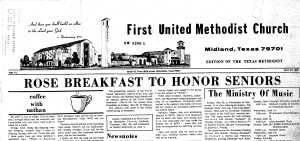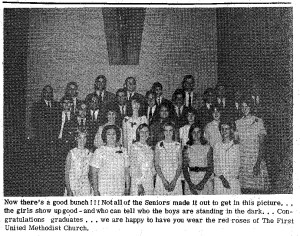In the famous balcony scene from Romeo and Juliet, the young heroine comments upon the fact their families abhor one another’s names. She contends that, beyond the stereotypes and prejudices, lies the essence of who we actually are. She reminds Romeo, “What’s in a name? That which we call a rose by any other name would smell as sweet.”
Each May, First Methodist provides a Rose Breakfast for the graduating seniors of the congregation, recognizing their arrival at a significant moment in their young lives and wishing them God’s blessings as they travel into the world of adulthood. Like all graduation celebrations, the morning is filled with rituals and ceremonies.
As the current Youth Director Kirk Dana began preparations for this event, he quickly recognized the Rose Breakfast was a revered institution of the Youth Department. Adults who grew up in the church could recall attending their own breakfast. Others remembered attending this occasion for one or more of their own children.
So it was logical that Kirk wondered just how old this institution was in the history of the church. He asked me as church historian if I knew. I admitted I didn’t but said I thought the church archives might possibly provide an answer. An answer did reside there, though a small degree of mystery remains regarding the origin of the Rose Breakfast.
I visited the church archives housed in the Parlor and began to dig my way back through the church newspapers seeking information. Now an electronic version (still called the Tower Times), the church paper has run under a number of different names over the years. First Methodist (which had its own share of name changes) originally launched a church newspaper in the mid-1940s and has continued to print church news (with few interruptions) in some form and fashion down to the present day.
My search process was to search across previous years, perusing papers from mid-April until locating a reference to the breakfast–either an announcement of the upcoming event or a feature written after the fact. Once I found a reference, I excavated further into the past. It did not take me long to realize this tradition went back a ways, so I began jumping by decades—to 1994, then 84, then 74—seeking a spring when I found no reference to this famous senior ceremony.

The event already included many trademarks that still characterize it. The seniors attended the worship service in their caps and gowns to be recognized. Their teachers, ministers, department superintendents, and adult workers also attended the breakfast. Nathan Pipkin, Director of Christian Education, spoke to the group on the subject of “Roses” and each honoree received a rose.
The article contained no mention of the origin of the name of this venerable tradition, how it was originally conceived nor who its founders might have been. The tradition of the roses was not explained and no copy of Mr. Pipkin’s address has surfaced.
In search of that elusive origin, I examined the papers from 1968. The May 31, 1968 issue contained a single photograph of the seniors. The group is in formal dress, not cap and gown and there is no mention of a breakfast. The photo caption does contain a somewhat enigmatic reference to the rose tradition. It reads, “Now there’s a good bunch!!! Not all of the Seniors made it out to get in this picture. . . . the girls showed up good—and who can tell who the boys are standing in the dark. . . Congratulations graduates. . . . we are happy to have you wear the red roses of The First United Methodist Church.”

However, a regular feature in that issue provided a few more tantalizing details. Nathan Pipkin penned a weekly column entitled “coffee with nathan” which he wrote in a conversational style summing up church events and reminding members of upcoming activities. Pipkin described a breakfast held at 7:00 am on Sunday, March 26, 1968 for the senior students. He specifically refers to the meal as the “Rose Breakfast” though he makes no mention of the roses worn by the graduates in the photograph. The morning’s events included the presentation of a bible and an “I AM A METHODIST” key ring to each senior by the Woman’s Society of Christian Service. The students attended the early morning worship service at 8:30 am (At that time there were two worship services, one at 8:30 am and one at 10:55. There was no Contemporary service).
In 1966, Jimmy Cameron served as the Youth Director. During his term, he wrote a weekly column for the paper on youth events. Several columns refer to an upcoming “Senior High Breakfast” which took place on Sunday April 17 at the Downtowner Motor Inn.
Church papers from 1967 make no mention of a breakfast. Instead seniors were honored in their Sunday school department and sat together at the 11:00 am service. They were dressed in their cap and gown for the group photograph. By 1967, Cameron was gone and Nathan Pipkin, listed in the church directory as Director of Christian Education, apparently also served as Youth Director or helped supervise the youth department.
Based upon the church archives, I reported to Kirk that the Rose Breakfast began in 1968 under the leadership of Nathan Pipkin and grew to headline status by the following year. Thus the Rose Breakfast began in a hallmark year and month of First Methodist Midland history. The current sanctuary, the fourth in the church’s life, was completed in 1968. The open house for the new sanctuary took place on May 5 and the Class of 1968 became the first to pose in front of the Cross of Glory Chancel window—marking an annual tradition that has continued for 47 years.
